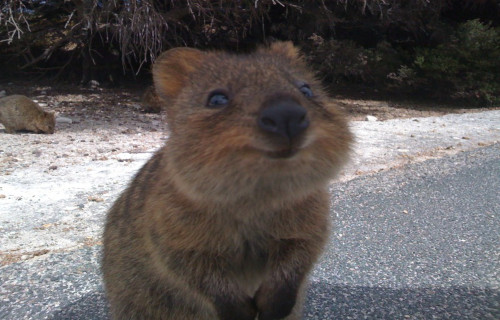
We hope that each of you, our readers, will enjoy and appreciate this article we present about these 3 Manifestly Marvelous Macropods. It was certainly our pleasure to compile the information for you. May it provide you with both education and increased awareness.
Certainly, however, the few species listed herein represent only a portion of the remarkable avians found in the region. It’s our belief, though, that they serve as excellent examples of the wonders found here. Check out some of our other articles for similar marvels.
Swamp Wallaby
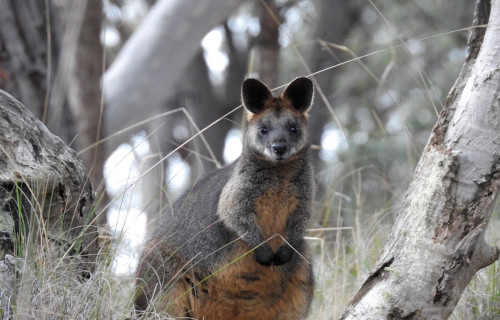
Swamp Wallaby Facts
- Leading off this article about 3 Manifestly Marvelous Macropods we present the remarkable mammal best known as the Swamp Wallaby.
- This amazing marsupial, similar to a kangaroo, most frequently goes by the common name we’ve used herein. That’s not its only name, though, by far. In fact, this fascinating creature also goes by a relatively long list of alternate common names.
- These include the fern wallaby, black-tailed wallaby, black wallaby, stinker, black stinker, and black pademelon. The terms of stinker and black stinker, though, derive from its distinctive odor. Many who encounter it compare it to the smell of a swamp.
- Regardless of the common name one uses, professional researchers know it better by its scientific name. That’s the comparatively simple to pronounce term of Wallabia bicolor. This animal, in fact, represents the only known living member of its Genus.
- The French zoologist, Anselme Gaetan Desmarest recorded the first known official recognition of the species in 1804. Another French zoologist, Edouard Louis Trouessart, later made the formal recognition of its status as the sole member of its group.
- Quite sadly, the awesome Swamp Wallaby appears to have been eradicated in parts of its native range. In its remaining range, however, it seems to be maintaining a stable population base. The IUCN therefore currently list it as Least Concern on its Red List.
- The mammal nevertheless faces threats to its continue survival. One of these continues to be that of habitat loss, due to human expansion. It greatest threat, however, no doubt comes from the ever-increasing danger now posed by ongoing climate change.
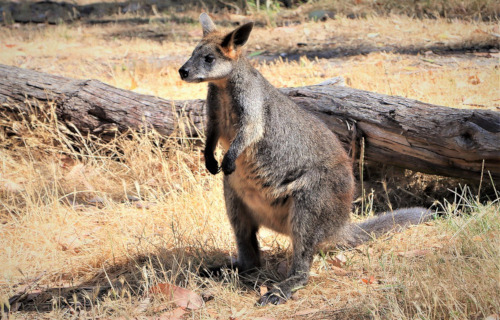
Swamp Wallaby Physical Description
The marvelous Swamp Wallaby, it must be noted, impresses those who encounter it for reasons other than sheer physical size. That’s because, especially compared to the four currently known forms of its nearest relative, the kangaroo, it’s a fairly small species.
Like many mammals, however, it also displays a slight degree of the physiological trait of sexual dimorphism. In its case, though, this characteristic manifest itself in terms of pure physical size. Specifically, males average slightly larger than the females.
To be precise, males of the remarkable Swamp Wallaby attain an average body length of roughly 30 in (76 cm). The females, meanwhile, reach a somewhat shorter average body length of about 28 in (70 cm). This measurement does not include the tail, though.
In both genders, this appendage attains a length approximately equal to that of the body itself. Males also achieve a moderately greater weight than the females. The larger males average a weight of about 37 lb (17 kg). Females, however, only average around 29 lb (13 kg).
The name of the species, bicolor, stems from its coloring. The basic color of the coat is a dark to light gray. A dark brown to black region appears on the back of the Swamp Wallaby, though. A light yellow to dark orange section also develops on the chest of the animal.
- Kingdom: Animalia
- Phylum: Chordata
- Class: Mammalia
- Order: Diprotodontia
- Family: Macropodidae
- Genus: Wallabia
- Species: W. bicolor
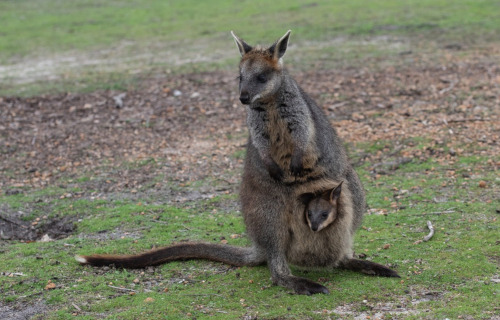
Swamp Wallaby Distribution, Habitat, and Ecology
Unfortunately for it, the truly amazing Swamp Wallaby evolved as native to a very small section of the world. That region’s also highly specific, as well. That’s due to the regrettable fact that this intriguing specimen of evolution only appears natively in eastern Australia.
Even more precisely, it currently only lives in a section of the continent that extends from southwestern Victoria to northern sections of Queensland. This zone of habitation also mainly hugs areas along the coast, reaching only a relatively short distance inland.
Previously, it appeared in most of the southeastern portions of the continent, however. Wherever it appears, though, it displays highly specific preferences in its choice of habitat. The marsupial primarily lives in regions of woodlands and forest, with thick undergrowth.
The beautiful Swamp Wallaby evolved as a primarily nocturnal creature. Typically emerging at night to feed, therefore, when it does it consumes a wide range of local plant life. These mainly include grasses, scrubs, but sometimes include local agricultural species.
This animal evolved another fascinating trait, exhibited by fewer than 100 known mammals. That’s the trait known as embryonic diapause. This literally allows it to become pregnant while already pregnant. Due to this, many females spend their entire adult life pregnant.
Nature further created in this species a principally solitary creature. One of the few exceptions to this characteristic occurs during feeding, however. At this time, it frequently congregates into small groups. In turn, though, it appears to have very few natural predators.
Quokka

Quokka Facts
- Next up among our choices for inclusion in this collection of 3 Manifestly Marvelous Macropods is the attention-grabbing Quokka.
- The short term applied here serves as the english language name for a clearly unique animal. This represents a derivation of the name given it by the aboriginal population of its native range. Though uncertain, it’s believed the original term was gwaga.
- For the moment, it holds no other accepted common name. The first known sighting of this species by someone other than those native to the region occurred in 1658. At that time, a Dutch mariner named Samuel Volckertzoon reported a sighting.
- The IUCN presently lists the creature as Vulnerable. That status appears on the organization’s published Red List of Threatened Species. The amazing animal also represented one of the first known mammals to be seen by Europeans.
- Unfortunately, however, only a few scattered concentrations seem to now exist within its natural range. It also remains undetermined if this animal ever possessed a more extensive area of habitation. Presently, scientific research into this remains ongoing.
- This fantastic marsupial also holds an extremely docile and outgoing demeanor. Unlike most wild animals, individuals of this species in the wild openly approach humans when encountered. Sadly, this sometimes works against the remarkable Quokka.
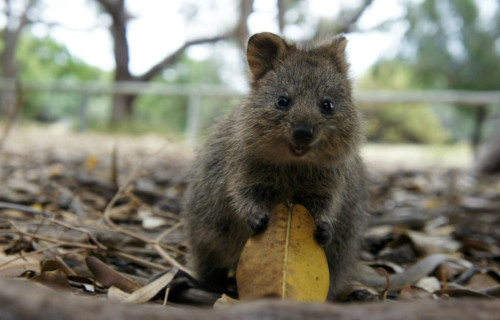
Quokka Physical Description
Perhaps most notably, the incredible Quokka attains only a moderate physical size. That’s because the animal reaches a size roughly equal to that of many species of domestic feline. In fact, its body typically measures about 21 in (54 cm) in head and body length.
The species, like many others, displays the physiological trait of sexual dimorphism. In its case, this characteristic manifests in terms of sheer size. More specifically, females typically attain both shorter head and body lengths, as well as remaining slightly lighter in weight.
Intriguingly, the tail of this species grows comparatively short for a macropod. That’s due to the fact that it only averages about 12 in (30 cm) long. Exceptional individuals of either gender weigh up to 11 lb (5 kg), though most average perhaps half of that.
The overall build of the Quokka further usually develops as relatively stocky in shape. The head also generally develops relatively broad. Added to this is the fact that the ears appear rounded in shape. Its fur also grows course and generally dark brown to light brown.
- Kingdom: Animalia
- Phylum: Chordata
- Class: Mammalia
- Order: Diprotodontia
- Family: Macropodidae
- Genus: Setonix
- Species: S. brachyurus
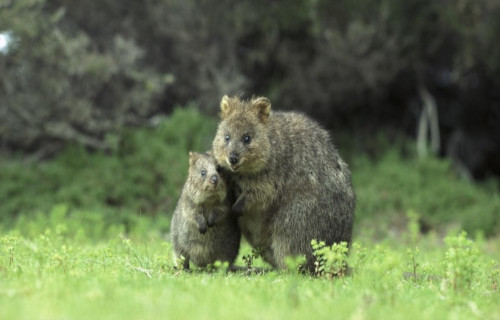
Quokka Distribution, Habitat, and Ecology
Sadly for those who love Nature, the Quokka currently only inhabits an extremely limited range of the world. That particular region, however, likely comes as no surprise to those who learn of it. That’s due to the fact that it inhabits an area well known for its wonders.
That’s because the amazing, as well as visually appealing, animal lives on the continent of Australia. Even there, though, its range is limited. Only a few populations of the animal still exist. These remain mostly confined to small islands situated off the western coast.
Yet, a few small, isolated populations of the mammal do occur in other locations. Only one colony is known to exist on the mainland of the continent, though. This small population of the marvelous species dwells within the confines of Two Peoples Bay Nature Reserve.
Though capable of climbing trees, the animal prefers to inhabit areas of dense ground cover. This it uses for protection from predators. This animal is primarily nocturnal by nature. It evolved as herbivorous in nature and feeds predominantly on endemic flower species.
The Quokka also faces other threats besides its limited range. In fact, combined with the highly limited territorial range, the primary threat to its existence comes from introduced predator species. These non-native threats it now faces mainly include cats, dogs, and foxes.
Tree Kangaroo
Tree Kangaroo Facts
- Closing out this compendium of 3 Manifestly Marvelous Macropods comes the astonishing mammal best known by the moniker of Tree Kangaroo.
- This very descriptive term serves as the collective common name for about 12 separate species in the genus Dendrolagus. The uncertainty about the number of member species arises from differences of opinion regarding classification among scientists.
- All members of this amazing genus have one outstanding trait in common. The various species in the genus actually evolved as arboreal creatures. This group of remarkable animals also presently remains the only known arboreal macropods.
- Individuals of the various species all typically remain very slow and clumsy on the ground. The surprising mammal moves haltingly, and hops awkwardly. In the trees, though, it actually appears to be extremely agile and a very effective climber.
- This fantastic creature also ranks as a highly powerful leaper, much like its terrestrial cousins. It has been seen to jump as much as 30 ft (9 m) from one limb to another. It can also jump to the ground from as high as 59 ft (18 m) without incurring injury.
- Quite unfortunately, the IUCN currently lists the majority of known members in this incredible genus as Threatened. This regrettable listing appears in its Red List of Threatened Species. Only a few varieties do not hold this sad status.
- The reasons for this lamentable status, though, vary. These do, however, include factors such as habitat loss and human hunting. But, the Tree Kangaroo also now faces the ever-increasing danger of climate change, much like other creatures.
Tree Kangaroo Physical Description
The Tree Kangaroo continues to amaze us. That’s partly because the animal evolved several adaptations useful for an arboreal life. For one thing, its back legs grow significantly broader and shorter than those of its terrestrial cousins. This provides it with better balance.
The incredible creature also has quite long, and extensively curved, nails on those rear legs. These serve a far more important purpose than mere aesthetics. In fact, the magnificent mammal routinely, and quite effectively, uses these for gripping and climbing.
But the differences between it and related species does not end there. The Tree Kangaroo also has a much broader and longer tail than a terrestrial kangaroo. This evolutionary divergence provides the animal with an enhanced balance while moving through the canopy.
Much like terrestrial kangaroos, it remains physically incapable of sweating, to cool its body. The mammal developed an alternate method of thermo-regulation. Instead of sweating, it licks its forearms and allows the moisture to evaporate, thereby cooling it.
- Kingdom: Animalia
- Phylum: Chordata
- Class: Mammalia
- Order: Diprotodontia
- Family: Macropodidae
- Genus: Dendrolagus
Tree Kangaroo Distribution, Habitat, and Ecology
Unfortunately, the only known forms of the surprising Tree Kangaroo inhabit a highly restricted and vulnerable region of the world. This unfortunately limited region consists primarily of the rainforest regions of New Guinea, parts of Queensland, Australia.
The majestic creature also appears on a few local islands, though. For the moment, experts remain undecided as to how this occurred. Within this varied range, the various species within the genus understandably have somewhat different habitat preferences.
As a general principle, the majority of the different species in the genus prefer to live in various montane areas. There nevertheless remain several varieties that typically prefer to dwell in lowland areas. These more commonly encounter humans than the others.
This animal has even more specific habitat requirements. That’s due to the fact that it thrives in treetops, instead of the ground like its genetic cousins. The reason it managed to adapt better to regions of high altitude than its terrestrial cousins remains a mystery.
Breeding during the monsoon season, Tree Kangaroo matings produce only one young per litter. Its main predator seems to be the amethystine python, which inhabits the same canopies. Being herbivorous in nature, its own diet consists principally of fruits and leaves.

3 Manifestly Marvelous Macropods
We hope that each of you completely enjoyed reading, and hopefully learning from, this article we’ve presented about 3 Manifestly Marvelous Macropods. It’s also our hope that doing so has left you with either a new or renewed appreciation for such wonders of Nature.
Unfortunately, however, many of their kindred around the world now find themselves facing strong threats to their continued existence as a species. Many of those dangers, in fact, stem from the actions of mankind. We must do all we can to protect and preserve them all.
Check out our other articles on 3 Amazing Birds of Asia, Fabulous Fungi Around the Globe, 5 Awesome Sharks of Australia, The Mighty Tornado
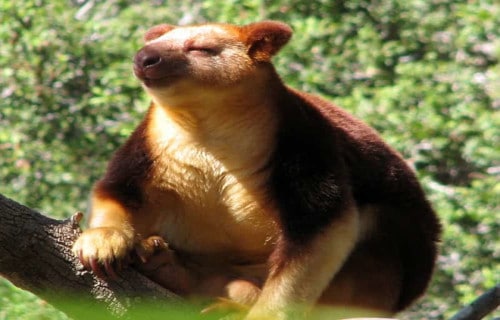
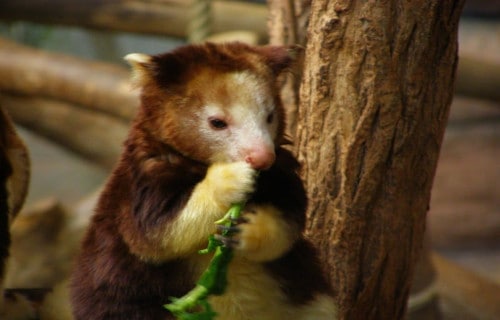
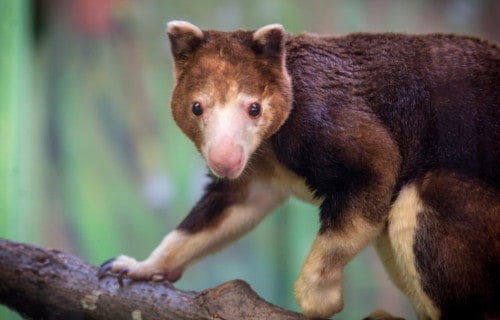









Leave a Reply